 |
 |
|
|
|
1. I chose this career because...
|
Back to Top

|
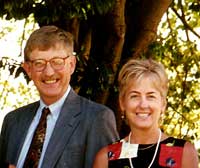
|
|
Barbara Biesecker is pictured with NHGRI Director, Dr. Francis Collins, who recruited her to the NIH for the job of her dreams.
|
I chose to become a genetic counselor because I loved genetics and wanted a career combining the life and social sciences. My interest in the natural sciences began in high school when I had an excellent teacher. My initial interest in genetics began in my advanced biology class as I worked on an extended project in drosophila genetics. However, it was a couple of key college professors who guided me into genetic counseling.
Undergraduate School: Discovering My Course
In college, I was a math and chemistry major and not interested in pursuing medical school. I had no skills in the laboratory despite being a good cook. I loved genetics and wanted a career that involved social contacts. A visiting professor at my college shared a New York Times article with me about an emerging profession called genetic counseling. It sounded exactly like what I was looking for. I switched my majors to biology and psychology and completed an innovative clinical rotation at the University of Minnesota in the medical genetics service.
Marriage and Career Development
My first job at the University of Kentucky helped launch my career because I worked directly for an excellent mentor. He threw me into many new situations having confidence that I could manage them. It was frightening, but he seemed to believe so strongly in my abilities that I couldn’t disappoint him. Now, I often try to emulate his skills at mentoring when working with young professionals.
During my almost thirty year career, I have held seven different genetic counseling positions, most were in pediatric genetics. I married a medical student and so there were many moves early in our married lives. Moving from position to position was hard, but I quickly learned that I was accumulating a variety of skills and gained an early confidence in starting new programs and in teaching. It became a goal of mine to direct a graduate program.
Realizing a Dream
At the University of Michigan, I worked closely with Francis Collins, MD, PhD, the current Director of NHGRI. He was recruited to the NIH to head the institute and to build an intramural genetics research program. He recruited my husband and I to join his team. He offered me the job of my dreams: to direct a training program and to conduct research. I have been at the NHGRI for nearly thirteen years now, enjoying the challenge of both aspects of my position.
I recently also began a doctoral program in health psychology from King’s College London. Each day I am grateful for my work and the opportunities that have been offered to me, particularly from terrific mentors. I now enjoy being a mentor to others.
College Education and Certification
- Bachelor of Arts, Biology and Psychology, St. Olaf College, (http://www.stolaf.edu/) Northfield, Minnesota
- Master of Science, Human Genetics with an emphasis on Counseling, University of Michigan, Ann Arbor, Michigan (http://www.umich.edu/)
- Currently enrolled in Doctoral Program, Health Psychology, King’s College London (http://www.kcl.ac.uk/), London, England, United Kingdom
- Certified Genetic Counselor, American Board of Genetic Counseling (http://www.abgc.net/)
|
|
2. My typical workday involves...
|
Back to Top

|
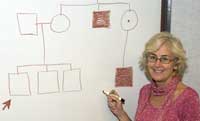
|
|
Barbara Biesecker draws a pedigree on the board, which can help her look for patterns of gene inheritance among generations of a family.
|
My typical workday is hard to describe because no two workdays are the same. The diversity is something I like very much about my work. Depending on the work that is necessary for the day, my tasks may include:
- Teaching - On a day that is primarily dedicated to teaching, I may supervise clinical students by listening to audiotapes of their sessions, and then teach a couple of courses in genetic counseling.
- Researching - On a research day, I may be working with collaborators to decide the best way to design a study, or to collect data from a survey we have developed. Once data has been collected, it has to be analyzed. If the data analysis is complete, I may be writing the results for publication.
- Speaking - I give many talks to other professionals in the field, as well as, talks to local community groups about the implications of genetic testing.
- Consulting - I see clients on occasion, either through a research study I am conducting, or as a genetics consultant.
|
|
3. What I like best/least about my work...
|
Back to Top

|
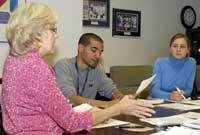
|
|
Barbara Biesecker enjoys mentoring and tries to model her former mentor who challenged her to succeed.
|
What I like best about my work is the diversity of my day and the challenging nature of the work. Genetics and its clinical translation is growing at a rapid pace. It is important to keep updated on the science and what it means for people. Even while you have an expertise, you are constantly learning. The best part of my job is teaching, mentoring and supervising graduate students. When you work with emerging professionals, you are constantly challenged to justify what you are doing or why. It keeps you humble and stimulated at the same time.
What I like least about my work is the meetings and administration that are needed to hold the infrastructure together. Though necessary, they are time consuming and don’t always address interesting or important issues. I also do not like adversity in personnel issues but am fortunate to be working with a fabulous group of students, colleagues and mentors so this is not a routine part of my job. It’s very nice to like not only what you do, but also who you do it with.
|
|
4. My career goals are...
|
Back to Top

|
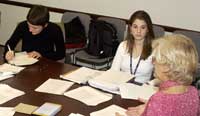
|
|
Barbara Biesecker meets with colleagues to discuss research data.
|
My career goals are to complete my doctoral degree and continue my work. My initial career goals were to direct a graduate program and conduct research, and I am doing both. I suppose once I complete my doctoral degree there will be new options to consider. Most likely, I will continue to conduct research with interesting collaborators and mentees, but hopefully with a renewed and more robust effort.
|
|
5. When I'm not working, I like to...
|
Back to Top

|
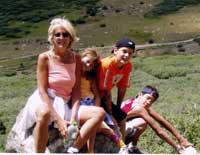
|
|
Barbara Biesecker enjoys a hike with her family during a recent vacation.
|
When I’m not working, I like to spend time with my family. I am usually busy transporting my children to their various activities. We have three or four big family vacations each year, the latest was snorkeling with sea turtles in Maui. It was awesome. Family time is important in dual career families. My spouse, who also works at NHGRI as a research medical geneticist, shares in the household management and kid responsibilities. With a fifteen-year-old, eleven-year-old and a seven-year-old, it seems even more important to be around as much as possible.
|
|
6. Choosing a career...
|
Back to Top

|
|
|
My advice about choosing a career is to try it on and see how it fits. Spend a lot of time thinking about it, but also see it and experience it during an internship early in your professional development. Graduate school is so much more appropriate and fun if you have found a good match of interests and skills to your chosen field. Always do work that you love and make it your goal to work with people you like. Challenge yourself to do more than you think you can. You will surprise yourself.
|
|
|
|
 |